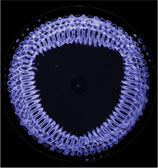Nature's Divine Frequency
432 hz – Natures Musical Tuning
By Stuart Mitchell
On starting this article I have been struck by the diversity of opinion on 432 hz and its roots and meaning within the musical concert pitch context. This is simply because, nothing, I repeat, nothing is actually in perfect tune from bottom of a scale to the top of the scale. All notes eventually go out of tune due to the ratios and mathematics governing the harmonic scale, which are the overtones to each and every single note.
 432 Hz or ‘cycles’ has been born out of the research and calculations of Pythagoras in 500 BC, calculated using the Pythagorean method of 3:2 ratio for dominants, 11:8 for sub-dominants, 2:1 for octaves. But the key question to why even Pythagoras or Plato chose this central frequency can be found in nature. To the right here is a cymatics pattern at 432 Hz created by John Reid on the Cymascope: www.cymascope.com
432 Hz or ‘cycles’ has been born out of the research and calculations of Pythagoras in 500 BC, calculated using the Pythagorean method of 3:2 ratio for dominants, 11:8 for sub-dominants, 2:1 for octaves. But the key question to why even Pythagoras or Plato chose this central frequency can be found in nature. To the right here is a cymatics pattern at 432 Hz created by John Reid on the Cymascope: www.cymascope.com
Since the very beginning of our human consciousness we have been evolving ourselves within the expression of our day to day life experiences, in music. It would appear natural for us to do this as creative human beings, but we are not alone, and species that have existed from millions of years have been doing the same thing. In fact, I believe that a creative harmonious musical species, such as Birds, Bee’s, Whales and Dolphins have survived precisely because of this collaboration with nature’s tuning.
All the questions running around the net on whether Verdi used this tuning, Mozart or Bach’s Well Tempered Clavichord (which was the foundation to straighten out the Pythagoras system which left the top end and bottom end out of tune, ‘cheating the ear’) are all meaningless until we ask ourselves..
Where and how did the birds find ‘their’ central tuning system in nature?
In my opinion after years of research into the properties of DNA, music is embedded within the data of DNA to be musically creative and artistic. Every living organism is born an artist with an ear, eye and heart to harmonize with the planets resonance/environment.
DNA adapts to environmental change and resonates with the frequency of Earths Biosphere. The Schumann Resonance
 Every cell of our bodies, heart, and mind have grown up with the Earth’s heart beats and being in harmony keeps all that is alive on Earth healthy. It is an essential program deep in the DNA code that maintains stability and growth of each species. So it becomes understandable now why the animals have such a ‘perfect pitch’, because their DNA is a biological music instrument that tunes itself to its planetary environment in order to develop and survive.
Every cell of our bodies, heart, and mind have grown up with the Earth’s heart beats and being in harmony keeps all that is alive on Earth healthy. It is an essential program deep in the DNA code that maintains stability and growth of each species. So it becomes understandable now why the animals have such a ‘perfect pitch’, because their DNA is a biological music instrument that tunes itself to its planetary environment in order to develop and survive.
Quote from Vincent Bridges Green Language of Light at: http://www.jwmt.org/v1n4/readlight.html
‘…we know that DNA emits a weak form of coherent light that has been demonstrated to work like a communication system between cells and even between larger organisms. In this sense, the art of light is indeed the instrument of the spirit. It is nothing less than the mechanism, the framework so to speak, that allows Mind to exist in the universe. The language of light emitted and received by the DNA may be the original of all languages, the ultimate language of initiation.’
Fulcanelli clearly understood this, as he shows when he states that argot, the initiation of the Argonauts, is but ‘one of the forms derived from The Language of the Birds.’ This Ur-language, Fulcanelli insists, is the common language of initiation and illumination behind cultural expressions.
Repertoire & Pitch
Songbirds remember many different songs which they regularly repeat. The European blackbird has a repertoire of some 22-48 songs whereas a nightingale may have up to 300! One of the most astounding musical abilities of birds is their control of their song’s key.
Many birds have what is musically known as ‘absolute pitch’ – the ability to determine exactly what key they sing in without reference to other sounds. If you hear a bird singing a song in G major, you will find it singing the same song in G major on subsequent occasions.
Now this is interesting because Mozart owned a Starling which would sing to him everyday, eventually providing Mozart with a melody for his Piano Concerto in, you guessed it, G Major.

In the interplay between Piano and Orchestra it is almost as if Mozart is ‘singing with’ the Starling in a symphonic embrace of mutual creativity. This was a wonderful collaboration between Mozart and nature and one of the most famous and recognisable melodies of Mozart’s complete output.
This brings into question the tuning of Mozart’s piano and/or tonal ear..
Did Mozart choose the key of this piece because the bird was singing in G Major?
It is quite possible he did, but it is also possible, because birds are such good mimics, that the bird picked up the key by its own ear, which is more likely. But the fact remains that Mozart was deeply moved by the Bird’s song that they collaborated together on a musical work, refined to perfection by Mozart, into an unforgettable and eternal inspiration of nature.
Mozart is not alone here, as in the song cycle Die Schone Mullerin, Schubert set to music a poem in which a starling is given a romantic mission: ‘I’d teach a starling how to speak and sing, / Till every word and note with truth should ring, / With all the skill my lips and tongue impart, / With all the warmth and passion of my heart’
And again, the majority of the Keys in this Song Cycle are in the keys of G Major or G Minor. Coincidence or not, it shows that even the greatest musical ears of history were listening to the birds since they are the great musicians of our mother Earth.
 Many composer’s have been inspired by nature to ‘tune’ their musical instruments and creativity toward a musical pitch or ‘heart-beat’ that is all around them pulsating invisibly from the heart chakra of the planets herself.
Many composer’s have been inspired by nature to ‘tune’ their musical instruments and creativity toward a musical pitch or ‘heart-beat’ that is all around them pulsating invisibly from the heart chakra of the planets herself.
I listen to the animals and their frequencies for a tuning system and 432 Hz appears to be what they are centrally tuned to, to my ear. In all the passage of time that has passed before us, we have been in the audience to a music that is in perfect harmony with nature and provided to us every day by the sounds and musical gestures put forward by species that have successfully survived employing this musical expression since DNA first arrived here on Earth. We are musical ambassadors of DNA, if not the ultimate musical expression of nature, every one of us. Because we understand today how important music is in the fabric of our physical reality, we can begin to interact with it harmoniously and potentially for the survival of our species based upon the current musical species around us today.
If we are ‘in tune’ with the Earth, we, as a species are within it’s full of potential.
Potential is the means of our DNA’s survival.
Content courtesy of Stuart Mitchell
Copyright (c) 2011. All Rights Reserved.









